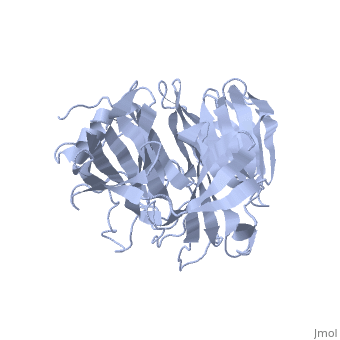1xip
From Proteopedia
Crystal Structure of the N-terminal Domain of Nup159
Structural highlights
Evolutionary ConservationCheck, as determined by ConSurfDB. You may read the explanation of the method and the full data available from ConSurf. Publication Abstract from PubMedNuclear export of mRNA in eukaryotic cells is mediated by soluble transport factors and components of the nuclear pore complex (NPC). The cytoplasmically oriented nuclear pore protein Nup159 plays a critical role in mRNA export through its conserved N-terminal domain (NTD). Here, we report the crystal structure of the Nup159 NTD, refined to 2.5 A. The structure reveals an unusually asymmetric seven-bladed beta-propeller that is structurally conserved throughout eukarya. Using structure-based conservation analysis, we have targeted specific surface residues for mutagenesis. Residue substitutions in a conserved loop of the NTD abolish in vitro binding to Dbp5, a DEAD box helicase required for mRNA export. In vivo, these mutations cause Dbp5 mislocalization and block mRNA export. These findings suggest that the Nup159 NTD functions in mRNA export as a binding platform, tethering shuttling Dbp5 molecules at the nuclear periphery and locally concentrating this mRNA remodeling factor at the cytoplasmic face of the NPC. The N-terminal domain of Nup159 forms a beta-propeller that functions in mRNA export by tethering the helicase Dbp5 to the nuclear pore.,Weirich CS, Erzberger JP, Berger JM, Weis K Mol Cell. 2004 Dec 3;16(5):749-60. PMID:15574330[1] From MEDLINE®/PubMed®, a database of the U.S. National Library of Medicine. See AlsoReferences
| ||||||||||||||||||||


